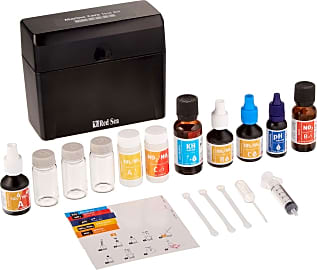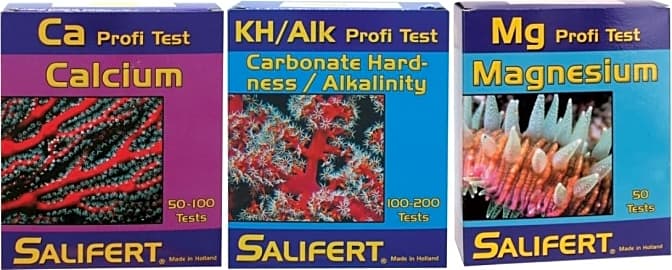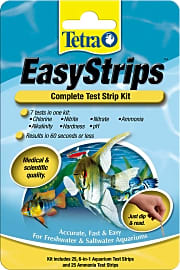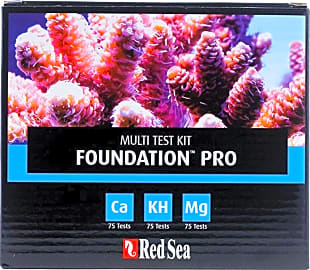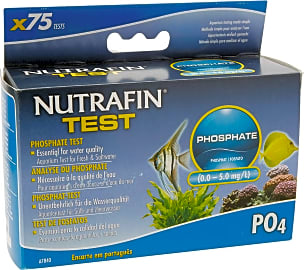The 7 Best Aquarium Test Kits

This wiki has been updated 34 times since it was first published in October of 2016. Keeping an aquarium in your home or office adds a focal point that is both handsome and fascinating. However, tropical fish ownership can be an involved undertaking that requires research and regular maintenance. You can save yourself time and help keep your aquatic friends healthy by using one of these test kits, which evaluate everything from pH levels to magnesium concentrations. When users buy our independently chosen editorial recommendations, we may earn commissions to help fund the Wiki.
Editor's Notes
April 10, 2019:
We included the best all-in-one solutions for freshwater and saltwater tanks, plus some we added some auxiliary tests that aren't included in the master kits, for specific problems, like the Nutrafin Phosphate for users who are struggling with algae growth. The top two spots went to the API Freshwater Master Kit and the Red Sea Marine Care because they provide users with the most important tests that need to be performed the most often for their respective types of aquariums.
A Brief History of Aquariums
Mankind first brought fish into their homes nearly two millennia ago.
Mankind first brought fish into their homes nearly two millennia ago. You may be wondering, how was it possible to maintain fish vitality in the days prior to pumps, filters, and all the other gear modern aquariums use today?
That question didn't stop the Romans, however, as they began housing sea barbels in marble tanks as early as 50 C.E.
In China towards the end of the tenth century, ceremonial goldfish were often kept by the wealthy in porcelain bowls. They were seen as status symbols, and much like today, eating your goldfish was frowned upon. This practice soon spread to Japan, where the art of breeding those fish blossomed.
The glass aquarium made its debut in 1832, when French marine biologist Jeanne Villepreux-Power created a clear bowl to create an unobstructed view of her paper nautilus. By this time, it was understood that fish also needed oxygen to live, and a few decades later a British chemist named Robert Warrington theorized that throwing a few plants in the bowl should allow fish to live forever.
While Warrington's theory wasn't entirely correct, it did form the basis of most aquarium construction for the next hundred years or so. Another Brit, Philip Henry Gosse, would take all these ideas and run with them, creating the first public aquarium in London.
In 1908, the first air pump hit the scene, and it ran on water rather than electricity. Filtration would come along fifty years later, with the invention of an under-gravel filter, and the hobby was truly beginning to take shape. Around that same time, live food was largely abandoned for the flaked variety of most domestic fish.
A tar and silicone sealant was developed in the 1960s by Californian Martin Horowitz, and this new material enabled the construction of the first all-glass aquariums. This, combined with improvements in shipping practices due to the use of plastic bags, made the hobby more accessible, as people were now able to house a wide variety of exotic fish — and they could actually see them.
As many as ten million Americans keep fish today, and it's one of the most popular hobbies on the planet. There's a wide variety of high-tech gear available to keep those fish alive and healthy, and it's easier than ever to store a few swimmers in your house without finding them belly-up every morning.
Finding the Right Balance for Your Aquarium
It's strange to think that fish are so particular about the makeup of the water they're willing to live in. After all, it hardly seems like the ocean goes through any trouble trying to fine-tune its pH balance or anything (although even the seas might need help keeping their fish alive).
The fact of the matter is, unless you get the water in your tank exactly right (or pretty close to it), you could seriously affect the health of your fish, and even shorten their lifespans — perhaps dramatically.
It's strange to think that fish are so particular about the makeup of the water they're willing to live in.
The first thing you should know about testing your water is that there are a variety of factors to examine, and not all test kits look at each one. Some only search for one particular thing, like copper or ammonia levels, while others give a more comprehensive panel. Before you buy a kit, you should do some research on your fish to find what kind of water levels they prefer, and then find an option that tests for those particular aspects.
Doing this research is critical, because not all fish can survive in the same water. Different species require different temperatures, alkalinity levels, and ratios of other elements, so make sure that your babies can peacefully coexist.
Most kits come with a test tube, testing solution, and a color card. You fill the tube with water from your tank, add a few drops of solution, and then compare the resulting hue of the water to the card. The kit should also have instructions that tell you what ranges you should be looking for.
There are some models that use strips instead of tubes, but these tend to be less accurate. If you really want to do a deep dive into your fish's water (not literally — that gets messy), then you can invest in meters and probes instead. These can cost hundreds of dollars, though, so they're best reserved for serious hobbyists.
Depending on the results of your tests, you might need to change your filter, vacuum up gravel, replace some water, or treat it with specialized kits. It takes a little fine-tuning, but with the help of your tester kit, you should be able to find the perfect balance in no time.
Benefits of Keeping Fish
With all the work that can go into maintaining an aquarium, you might wonder why people even bother. However, owning fish offers some benefits that you'd be hard-pressed to find anywhere else.
There are myriad health benefits to having a fish tank. It's been shown to lower blood pressure, soothe anxiety, and increase happiness, which is why many doctors and dentists have aquariums.
However, owning fish offers some benefits that you'd be hard-pressed to find anywhere else.
Now, you can get those benefits from owning just about any pet — but, on balance, fish are much lower maintenance than other options. All you have to do is feed them and perform regular upkeep on their tank. You don't have to walk them, they'll never chew up your shoes, and you'll rarely get an angry phone call from your neighbors asking you to shut your stupid fish up.
You can find aquariums in a variety of sizes, making fish the perfect pet regardless of your living situation. Even if you have a tiny studio apartment, you can almost certainly find room for a finned friend or two.
The biggest reason, though, may be that they're simply fun to watch. It's extremely peaceful to look at them swimming around, and they can add a touch of class and a splash of color to your living space.
The main downside? They're absolutely terrible at cuddling.


